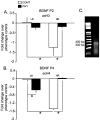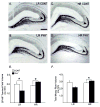Chronic variable physical stress during the peripubertal-juvenile period causes differential depressive and anxiogenic effects in the novelty-seeking phenotype: functional implications for hippocampal and amygdalar brain-derived neurotrophic factor and the mossy fibre plasticity
- PMID: 21767611
- PMCID: PMC3166372
- DOI: 10.1016/j.neuroscience.2011.06.077
Chronic variable physical stress during the peripubertal-juvenile period causes differential depressive and anxiogenic effects in the novelty-seeking phenotype: functional implications for hippocampal and amygdalar brain-derived neurotrophic factor and the mossy fibre plasticity
Abstract
Experimentally naive rats show variance in their locomotor reactivity to novelty, some displaying higher (HR) while others displaying lower (LR) reactivity, associated with vulnerability to stress. We employed a chronic variable physical stress regimen incorporating intermittent and random exposures of physical stressors or control handling during the peripubertal-juvenile period to assess interactions between stress and the LRHR phenotype in depressive- and anxiety-like behaviors on the forced swim and social interaction tests, respectively. A decrease in immobility in the forced swim test along with a decrease in social contact in the social interaction test were observed in the juvenile HRs, coupled with increases in brain-derived neurotrophic factor (BDNF) mRNA in the hippocampus and in the basolateral amygdala with chronic variable physical stress. In contrast, an increase in immobility in the forced swim test and a decrease in social contact was observed in the LR counterparts coupled with an increase in the BDNF mRNA in the basolateral amygdala following chronic variable physical stress. Furthermore, chronic physical stress led to increased H3 and H4 acetylation at the P2 and P4 promoters of the hippocampal BDNF gene in the HR rats that is associated with increased suprapyramidal mossy fibre (SP-MF) terminal field volume. In contrast, chronic variable physical stress led to decreased H4 acetylation at the P4 promoter, associated with decreased SP-MF volume in the LR rats. These findings show dissociation in depressive- and anxiety-like behaviors following chronic variable physical stress in the juvenile HR animals that may be mediated by increased levels of BDNF in the hippocampus and in the amygdala, respectively. Moreover, chronic variable physical stress during the peripubertal-juvenile period results in opposite effects in depressive-like behavior in the LRHR rats by way of inducing differential epigenetic regulation of the hippocampal BDNF gene that, in turn, may mediate mossy fibre sprouting.
Published by Elsevier Ltd.
Figures






Similar articles
-
Stressful environmental and social stimulation in adolescence causes antidepressant-like effects associated with epigenetic induction of the hippocampal BDNF and mossy fibre sprouting in the novelty-seeking phenotype.Neurosci Lett. 2011 Aug 26;501(2):107-11. doi: 10.1016/j.neulet.2011.06.058. Epub 2011 Jul 8. Neurosci Lett. 2011. PMID: 21767606 Free PMC article.
-
Individual differences in novelty seeking predict subsequent vulnerability to social defeat through a differential epigenetic regulation of brain-derived neurotrophic factor expression.J Neurosci. 2013 Jul 3;33(27):11048-60. doi: 10.1523/JNEUROSCI.0199-13.2013. J Neurosci. 2013. PMID: 23825410 Free PMC article.
-
Hippocampal Y2 receptor-mediated mossy fiber plasticity is implicated in nicotine abstinence-related social anxiety-like behavior in an outbred rat model of the novelty-seeking phenotype.Pharmacol Biochem Behav. 2014 Oct;125:48-54. doi: 10.1016/j.pbb.2014.08.004. Epub 2014 Aug 23. Pharmacol Biochem Behav. 2014. PMID: 25158103 Free PMC article.
-
Stress and anxiety: structural plasticity and epigenetic regulation as a consequence of stress.Neuropharmacology. 2012 Jan;62(1):3-12. doi: 10.1016/j.neuropharm.2011.07.014. Epub 2011 Jul 27. Neuropharmacology. 2012. PMID: 21807003 Free PMC article. Review.
-
Epigenetic marking of the BDNF gene by early-life adverse experiences.Horm Behav. 2011 Mar;59(3):315-20. doi: 10.1016/j.yhbeh.2010.05.005. Epub 2010 May 17. Horm Behav. 2011. PMID: 20483357 Free PMC article. Review.
Cited by
-
Transferrin Receptor 2 Dependent Alterations of Brain Iron Metabolism Affect Anxiety Circuits in the Mouse.Sci Rep. 2016 Aug 1;6:30725. doi: 10.1038/srep30725. Sci Rep. 2016. PMID: 27477597 Free PMC article.
-
Juvenile exposure to acute traumatic stress leads to long-lasting alterations in grey matter myelination in adult female but not male rats.Neurobiol Stress. 2021 Apr 1;14:100319. doi: 10.1016/j.ynstr.2021.100319. eCollection 2021 May. Neurobiol Stress. 2021. PMID: 33937444 Free PMC article.
-
Sucrose Preference Test as a Measure of Anhedonic Behavior in a Chronic Unpredictable Mild Stress Model of Depression: Outstanding Issues.Brain Sci. 2022 Sep 24;12(10):1287. doi: 10.3390/brainsci12101287. Brain Sci. 2022. PMID: 36291221 Free PMC article. Review.
-
Early Life Adversity and Neuropsychiatric Disease: Differential Outcomes and Translational Relevance of Rodent Models.Front Syst Neurosci. 2022 Jun 23;16:860847. doi: 10.3389/fnsys.2022.860847. eCollection 2022. Front Syst Neurosci. 2022. PMID: 35813268 Free PMC article. Review.
-
A double-blind, rct testing beneficial modulation of BDNF in middle-aged, life style-stressed subjects: a clue to brain protection?J Clin Diagn Res. 2014 Nov;8(11):MC01-6. doi: 10.7860/JCDR/2014/10301.5141. Epub 2014 Nov 20. J Clin Diagn Res. 2014. PMID: 25584253 Free PMC article.
References
-
- Amaral DG, Witter MP. The three-dimensional organization of the hippocampal formation: a review of anatomical data. Neuroscience. 1989;31:571–91. - PubMed
MeSH terms
Substances
Grants and funding
LinkOut - more resources
Full Text Sources
Medical

